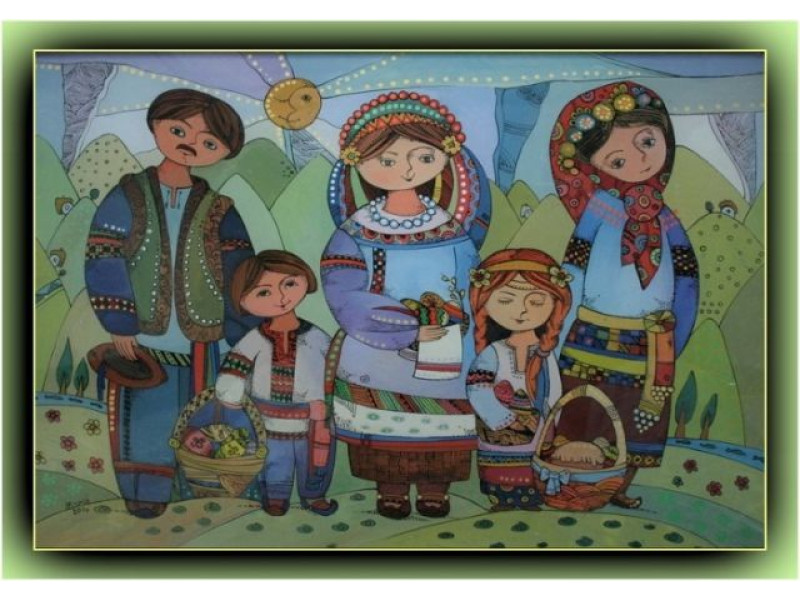Ukrainian folklore is rich in legends. It also has legends related to the Easter holiday and the rituals that accompany it. In this article, we will talk about some of them.
EASTER EGG AND PYSANKA

There is a well-known legend in Podillia that tells that when Christ was resurrected, he told the soldiers guarding his tomb to go and tell all the people about his resurrection. And so that the soldiers would believe, the Savior gave the soldiers an Easter egg from his tomb. Since then, the custom of making Easter eggs for Easter has begun.
***
A poor man was carrying eggs in a basket to the market to sell. At the same time, Jesus Christ was being led to be crucified. The cross was heavy and Jesus was falling under its weight. The man felt sorry for him and, leaving his basket on the road, went to help carry it, and carried it all the way to the crucifixion. When the man returned to the basket, he saw in it instead of ordinary eggs, Easter eggs and Easter cakes.
***
In the Kyiv region, there is a legend about how Jesus walked with Saint Peter on the ground. Passing through one village, its inhabitants began to throw stones and lumps of earth at the Savior. And when a stone touched Jesus’ clothes, it turned into an Easter egg, and when a lump touched it, it turned into an Easter egg. Saint Peter collected the stones in his pockets, and later distributed them to people.
***
In the Uman region, they say that when Christ was going to suffer, unbelievers tempted him. They put stones in the shroud and asked him: "What is in the shroud?", and he answered them: "Written and painted." They opened the shroud to laugh, and there were really Easter eggs and Easter cakes.
***
There is a legend in the Poltava region that the Mother of God made pysanky when Jesus was a little child. He was very happy with those little things.
***
In the Hutsul region, it is said that the Mother of God made Easter eggs and gave them to Pilate so that he would have mercy on her son. While making them, she cried and poured tears on the Easter eggs. Therefore, a technique is widespread in the Hutsul region, in which dots resembling tears are drawn.
***
There is also another legend in those places. Far away in the mountains, a terrible unchrist is chained to a high, steep rock with iron chains. He has twelve of his messengers who go around villages and cities and observe how people live, and then they tell him everything. When the messengers tell him that people live poorly and quarrel among themselves, the unchrist rejoices and laughs so much that the mountains shake and his chains weaken. If they tell him about harmony and goodness between people, the unchrist gets angry and the chains tighten around his body. But the most terrible news for him is that people still make Easter eggs and have not forgotten this custom. Then he roars like a beast, beats his head against the rock, so that fire rises, and he tries with all his might to free himself. From this, fire and lightning are made. And his chains become so strong that they cannot be broken.
ABOUT THE RESURRECTION OF CHRIST

In Kaniv County, there is a legend that tells that the archangel Gabriel appeared to the Mother of God on Saturday and said: "Your son will rise from the dead." She was having breakfast with fish, ate all the meat, and only the ribs were left. She crossed herself and said: "My son will rise, as this fish comes to life!" The fish came to life in an instant.
***
In Galicia, a legend is told in which a man eats a rooster and a hired man comes to him with the words "Christ is risen!". To this the man replies: "He will be resurrected, as this rooster comes to life!". As soon as he said this, the bones gathered together and the rooster came to life.
ABOUT EASTER

They say that there was once a man named Svirid. When he waited for Easter, he thought to himself: “People say it’s Easter, but I’ll also see if this day is really great.” On the first day of the Bright Holiday, he harnessed oxen and went to plow with them, while other people in the church prayed to God. As soon as he started working, something terrible roared underground, as if thunder had rumbled somewhere far away. Svirid, along with the plow and oxen, fell underground, and a grave was built in that place. It is still called “Svirid’s Grave.” They say that if you come to that grave and put your ear to the ground, you can sometimes hear someone driving oxen.
***
Easter is called so because it is said that on the day Christ was born, the sun shone brightly and the days were so long that seven of the current days would have to be added together to make one like before. As the sun rises on Sunday morning, it will not set until Saturday evening. After Christ was crucified, the days became shorter. Now only the gates in the church stand open for seven days, which is why this day is called Great.


Write a comment